Related Research Articles
Musicology is the scholarly study of music. Musicology research combines and intersects with many fields, including psychology, sociology, acoustics, neurology, natural sciences, formal sciences and computer science.
Music history, sometimes called historical musicology, is a highly diverse subfield of the broader discipline of musicology that studies music from a historical point of view. In theory, "music history" could refer to the study of the history of any type or genre of music. In practice, these research topics are often categorized as part of ethnomusicology or cultural studies, whether or not they are ethnographically based. The terms "music history" and "historical musicology" usually refer to the history of the notated music of Western elites, sometimes called "art music".

LilyPond is a computer program and file format for music engraving. One of LilyPond's major goals is to produce scores that are engraved with traditional layout rules, reflecting the era when scores were engraved by hand.
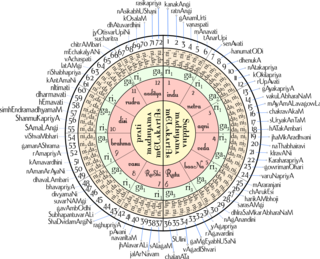
A raga is a melodic framework for improvisation in Indian classical music akin to a melodic mode. Rāga is a unique feature and central to the tradition of classical Indian music: no equivalent concept exists in classical European music. Each rāga is an array of melodic structures with musical motifs, considered in the Indian tradition to have the ability to "colour the mind" and affect the emotions of the audience.
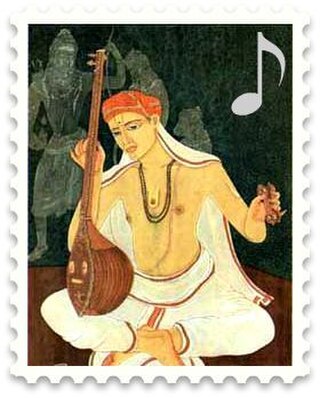
Indian classical music is the classical music of the Indian subcontinent. It is generally described using terms like Marg Sangeet and Shastriya Sangeet. It has two major traditions: the North Indian classical music known as Hindustani and the South Indian expression known as Carnatic. These traditions were not distinct until about the 15th century. During the period of Mughal rule of the Indian subcontinent, the traditions separated and evolved into distinct forms. Hindustani music emphasizes improvisation and exploration of all aspects of a raga, while Carnatic performances tend to be short composition-based. However, the two systems continue to have more common features than differences. Another unique classical music tradition from Eastern part of India, i. e. Odissi music has evolved since two thousand years ago.
Music information retrieval (MIR) is the interdisciplinary science of retrieving information from music. Those involved in MIR may have a background in academic musicology, psychoacoustics, psychology, signal processing, informatics, machine learning, optical music recognition, computational intelligence or some combination of these.
Optical music recognition (OMR) is a field of research that investigates how to computationally read musical notation in documents. The goal of OMR is to teach the computer to read and interpret sheet music and produce a machine-readable version of the written music score. Once captured digitally, the music can be saved in commonly used file formats, e.g. MIDI and MusicXML . In the past it has, misleadingly, also been called "music optical character recognition". Due to significant differences, this term should no longer be used.
Computer audition (CA) or machine listening is the general field of study of algorithms and systems for audio interpretation by machines. Since the notion of what it means for a machine to "hear" is very broad and somewhat vague, computer audition attempts to bring together several disciplines that originally dealt with specific problems or had a concrete application in mind. The engineer Paris Smaragdis, interviewed in Technology Review, talks about these systems — "software that uses sound to locate people moving through rooms, monitor machinery for impending breakdowns, or activate traffic cameras to record accidents."
Music informatics is a study of music processing, in particular music representations, fourier analysis of music, music synchronization, music structure analysis and chord recognition. Other music informatics research topics include computational music modeling, computational music analysis, optical music recognition, digital audio editors, online music search engines, music information retrieval and cognitive issues in music. Because music informatics is an emerging discipline, it is a very dynamic area of research with many diverse viewpoints, whose future is yet to be determined.

Shivaranjani or Sivaranjani is a musical scale used in Indian classical music. There are two scales, one in Hindustani music and one in Carnatic music. The Hindustani rāga is a pentatonic scale, as is the Carnatic scale categorized as Audava-Audava resulting in 5 notes in the Arohanam and 5 in the Avarohanam.
The Music Encoding Initiative (MEI) is an open-source effort to create a system for representation of musical documents in a machine-readable structure. MEI closely mirrors work done by text scholars in the Text Encoding Initiative (TEI) and while the two encoding initiatives are not formally related, they share many common characteristics and development practices. The term "MEI", like "TEI", describes the governing organization and the markup language. The MEI community solicits input and development directions from specialists in various music research communities, including technologists, librarians, historians, and theorists in a common effort to discuss and define best practices for representing a broad range of musical documents and structures. The results of these discussions are then formalized into the MEI schema, a core set of rules for recording physical and intellectual characteristics of music notation documents. This schema is expressed in an XML schema Language, with RelaxNG being the preferred format. The MEI schema is developed using the One-Document-Does-it-all (ODD) format, a literate programming XML format developed by the Text Encoding Initiative.
Cognitive musicology is a branch of cognitive science concerned with computationally modeling musical knowledge with the goal of understanding both music and cognition.
GUIDO Music Notation is a computer music notation format designed to logically represent all aspects of music in a manner that is both computer-readable and easily readable by human beings. It was named after Guido of Arezzo, who pioneered today's conventional musical notation 1,000 years ago.
Harmonic pitch class profiles (HPCP) is a group of features that a computer program extracts from an audio signal, based on a pitch class profile—a descriptor proposed in the context of a chord recognition system. HPCP are an enhanced pitch distribution feature that are sequences of feature vectors that, to a certain extent, describe tonality, measuring the relative intensity of each of the 12 pitch classes of the equal-tempered scale within an analysis frame. Often, the twelve pitch spelling attributes are also referred to as chroma and the HPCP features are closely related to what is called chroma features or chromagrams.
Sound and music computing (SMC) is a research field that studies the whole sound and music communication chain from a multidisciplinary point of view. By combining scientific, technological and artistic methodologies it aims at understanding, modeling and generating sound and music through computational approaches.
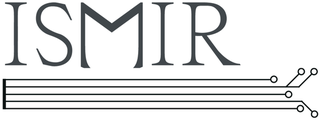
The International Society for Music Information Retrieval (ISMIR) is an international forum for research on the organization of music-related data. It started as an informal group steered by an ad hoc committee in 2000 which established a yearly symposium - whence "ISMIR", which meant International Symposium on Music Information Retrieval. It was turned into a conference in 2002 while retaining the acronym. ISMIR was incorporated in Canada on July 4, 2008.
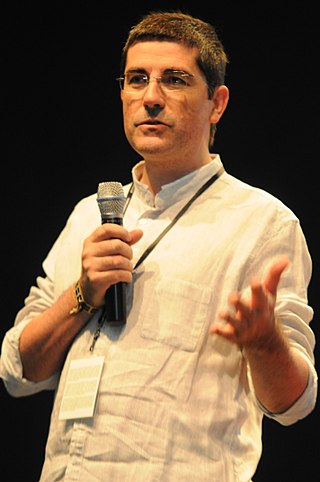
Xavier Serra is a researcher in the field of Sound and Music Computing and professor at the Pompeu Fabra University (UPF) in Barcelona. He is the founder and director of the Music Technology Group at the UPF.

David Huron is a Canadian Arts and Humanities Distinguished Professor at the Ohio State University, in both the School of Music and the Center for Cognitive and Brain Sciences. His teaching and publications focus on the psychology of music and music cognition. In 2017, Huron was awarded the Society for Music Perception and Cognition Achievement Award.
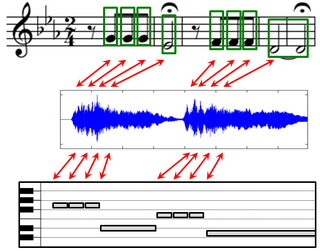
Music can be described and represented in many different ways including sheet music, symbolic representations, and audio recordings. For each of these representations, there may exist different versions that correspond to the same musical work. The general goal of music alignment is to automatically link the various data streams, thus interrelating the multiple information sets related to a given musical work. More precisely, music alignment is taken to mean a procedure which, for a given position in one representation of a piece of music, determines the corresponding position within another representation. In the figure on the right, such an alignment is visualized by the red bidirectional arrows. Such synchronization results form the basis for novel interfaces that allow users to access, search, and browse musical content in a convenient way.

In Western music, the term chroma feature or chromagram closely relates to twelve different pitch classes. Chroma-based features, which are also referred to as "pitch class profiles", are a powerful tool for analyzing music whose pitches can be meaningfully categorized and whose tuning approximates to the equal-tempered scale. One main property of chroma features is that they capture harmonic and melodic characteristics of music, while being robust to changes in timbre and instrumentation.
References
- ↑ "Unfolding the Potential of Computational Musicology" (PDF). Proceedings of the Thirteenth International Conference on Informatics and Semiotics in Organisations: Problems and Possibilities of Computational Humanities.
- ↑ Meredith, David (2016). "Preface". Computational Music Analysis. New York: Springer. p. v. ISBN 978-3319259291.
- 1 2 3 4 5 6 Hewlett, Walter B.; Selfridge-Field, Eleanor (1991). "Computing in Musicology, 1966-91". Computers and the Humanities. 25 (6): 381–392. doi:10.1007/BF00141188. JSTOR 30208121. S2CID 30204949.
- 1 2 Meinard, Müller (2015-07-21). Fundamentals of music processing : audio, analysis, algorithms, applications. Switzerland. ISBN 9783319219455. OCLC 918555094.
{{cite book}}: CS1 maint: location missing publisher (link) - ↑ Forte, Allen (1967). "Music and computing: the present situation". Computers and the Humanities. 2 (1): 32–35. doi:10.1007/BF02402463. JSTOR 30203948. S2CID 33681168.
- ↑ Berlind, Gary; Brook, Barry S.; Hiller, Lejaren A.; Larue, Jan P.; Logemann, George W. (Fall 1966). "Writings on the Use of Computers in Music". College Music Symposium. 6: 143–157. JSTOR 40373186.
- 1 2 Erickson, Raymond F. (1975). ""The Darms Project": A Status Report". Computers and the Humanities. 9 (6): 291–298. doi:10.1007/BF02396292. JSTOR 30204239. S2CID 62220033.
- ↑ "Papers of Jamie and Michael Kassler". Trove. Retrieved 2023-02-23.
- ↑ "ESAC Data Homepage". www.esac-data.org. Retrieved 2019-02-11.
- ↑ Pinegar, Sandra (1991). Textual and conceptual relationships among theoretical writings on measurable music of the thirteenth and early fourteenth centuries (PhD thesis). Columbia University. ProQuest 303944932.
- ↑ Huron, David (2002). "Music information processing using the Humdrum Toolkit: Concepts, examples, and lessons". Computer Music Journal. 26 (2): 11–26. doi:10.1162/014892602760137158. S2CID 25996361.
- ↑ Müller, Meinard (2015), "Music Representations", in Müller, Meinard (ed.), Fundamentals of Music Processing, Springer International Publishing, pp. 1–37, doi:10.1007/978-3-319-21945-5_1, ISBN 9783319219455
- ↑ The raga guide : a survey of 74 Hindustani ragas, Bor, Joep., Rao, Suvarnalata, 1954-, Meer, Wim van der., Harvey, Jane, 1949-, Chaurasia, Hariprasad., Das Gupta, Buddhadev, 1933-, Nimbus Records, 2002, ISBN 978-0954397609, OCLC 80291538
{{citation}}: CS1 maint: others (link) - ↑ "The Humdrum Toolkit: Software for Music Research — humdrum-tools 1 documentation". www.humdrum.org. Retrieved 2019-03-20.
- ↑ Cuthbert, Michael Scott; Ariza, Christopher (August 2010). "music21: A Toolkit for Computer-Aided Musicology and Symbolic Music Data". In J. Stephen Downie; Remco C. Veltkamp (eds.). 11th International Society for Music Information Retrieval Conference (ISMIR 2010), August 9-13, 2010, Utrecht, Netherlands. International Society for Music Information Retrieval. pp. 637–642. hdl:1721.1/84963. ISBN 9789039353813.
- ↑ Pablo Bello, Juan. "Low-level features and timbre" (PDF). nyu.edu. Retrieved 2019-02-11.
- ↑ McCollum, Jonathan and Hebert, David (2014) Theory and Method in Historical Ethnomusicology Lanham, MD: Lexington Books / Rowman & Littlefield ISBN 0739168266; p.62. Some of Jensen and Hebert's pioneering findings from 2013 on tendencies in US Billboard Hot 100 songs have since been replicated and expanded upon by other scholars (e.g. Mauch M, MacCallum RM, Levy M, Leroi AM. 2015 The evolution of popular music: USA 1960–2010. R. Soc. Open sci. 2: 150081. https://dx.doi.org/10.1098/rsos.150081).
- ↑ Kristoffer Jensen and David G. Hebert (2016). Evaluation and Prediction of Harmonic Complexity Across 76 Years of Billboard 100 Hits. In R. Kronland-Martinet, M. Aramaki, and S. Ystad, (Eds.), Music, Mind, and Embodiment. Switzerland: Springer Press, pp.283-296. ISBN 978-3-319-46281-3.
- ↑ Chakraborty, S., Mazzola, G., Tewari, S., Patra, M. (2014) "Computational Musicology in Hindustani Music" New York: Springer.
- ↑ RISM database, <http://www.rism.info/>
- ↑ Mazurka Project, <http://mazurka.org.uk/>
- ↑ Singer, Mark (2007-09-10). "Fantasia for Piano". The New Yorker. ISSN 0028-792X . Retrieved 2019-03-23.
- ↑ Huang, Cheng-Zhi Anna; Cooijmans, Tim; Roberts, Adam; Courville, Aaron; Eck, Douglas (2019-03-17). "Counterpoint by Convolution". arXiv: 1903.07227 [cs.LG].
- ↑ "Coconet: The ML model behind today's Bach Doodle". magenta.tensorflow.org. 20 March 2019. Retrieved 2019-03-23.